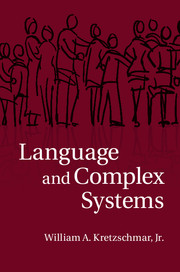Book contents
- Language and Complex Systems
- Language and Complex Systems
- Copyright page
- Dedication
- Contents
- Figures
- Tables
- Book part
- Introduction
- 1 Language and complex systems
- 2 Linguistics, science, the humanities, and complex systems
- 3 Usage-based linguistics and complex systems
- 4 Grammar and complex systems
- 5 Complex systems and the history of the English language
- 6 Neural networks and complex systems
- 7 Sociolinguistics, communities, and complex systems
- 8 Postmodernism and complex systems
- References
- Index
- References
References
Published online by Cambridge University Press: 05 June 2015
- Language and Complex Systems
- Language and Complex Systems
- Copyright page
- Dedication
- Contents
- Figures
- Tables
- Book part
- Introduction
- 1 Language and complex systems
- 2 Linguistics, science, the humanities, and complex systems
- 3 Usage-based linguistics and complex systems
- 4 Grammar and complex systems
- 5 Complex systems and the history of the English language
- 6 Neural networks and complex systems
- 7 Sociolinguistics, communities, and complex systems
- 8 Postmodernism and complex systems
- References
- Index
- References
- Type
- Chapter
- Information
- Language and Complex Systems , pp. 214 - 223Publisher: Cambridge University PressPrint publication year: 2015

